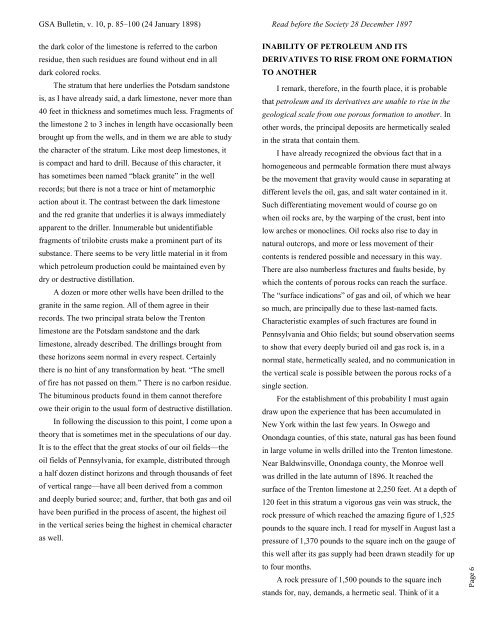Presidential Address - Geological Society of America
Presidential Address - Geological Society of America
Presidential Address - Geological Society of America
Create successful ePaper yourself
Turn your PDF publications into a flip-book with our unique Google optimized e-Paper software.
GSA Bulletin, v. 10, p. 85–100 (24 January 1898) Read before the <strong>Society</strong> 28 December 1897<br />
the dark color <strong>of</strong> the limestone is referred to the carbon<br />
residue, then such residues are found without end in all<br />
dark colored rocks.<br />
The stratum that here underlies the Potsdam sandstone<br />
is, as I have already said, a dark limestone, never more than<br />
40 feet in thickness and sometimes much less. Fragments <strong>of</strong><br />
the limestone 2 to 3 inches in length have occasionally been<br />
brought up from the wells, and in them we are able to study<br />
the character <strong>of</strong> the stratum. Like most deep limestones, it<br />
is compact and hard to drill. Because <strong>of</strong> this character, it<br />
has sometimes been named “black granite” in the well<br />
records; but there is not a trace or hint <strong>of</strong> metamorphic<br />
action about it. The contrast between the dark limestone<br />
and the red granite that underlies it is always immediately<br />
apparent to the driller. Innumerable but unidentifiable<br />
fragments <strong>of</strong> trilobite crusts make a prominent part <strong>of</strong> its<br />
substance. There seems to be very little material in it from<br />
which petroleum production could be maintained even by<br />
dry or destructive distillation.<br />
A dozen or more other wells have been drilled to the<br />
granite in the same region. All <strong>of</strong> them agree in their<br />
records. The two principal strata below the Trenton<br />
limestone are the Potsdam sandstone and the dark<br />
limestone, already described. The drillings brought from<br />
these horizons seem normal in every respect. Certainly<br />
there is no hint <strong>of</strong> any transformation by heat. “The smell<br />
<strong>of</strong> fire has not passed on them.” There is no carbon residue.<br />
The bituminous products found in them cannot therefore<br />
owe their origin to the usual form <strong>of</strong> destructive distillation.<br />
In following the discussion to this point, I come upon a<br />
theory that is sometimes met in the speculations <strong>of</strong> our day.<br />
It is to the effect that the great stocks <strong>of</strong> our oil fields—the<br />
oil fields <strong>of</strong> Pennsylvania, for example, distributed through<br />
a half dozen distinct horizons and through thousands <strong>of</strong> feet<br />
<strong>of</strong> vertical range—have all been derived from a common<br />
and deeply buried source; and, further, that both gas and oil<br />
have been purified in the process <strong>of</strong> ascent, the highest oil<br />
in the vertical series being the highest in chemical character<br />
as well.<br />
INABILITY OF PETROLEUM AND ITS<br />
DERIVATIVES TO RISE FROM ONE FORMATION<br />
TO ANOTHER<br />
I remark, therefore, in the fourth place, it is probable<br />
that petroleum and its derivatives are unable to rise in the<br />
geological scale from one porous formation to another. In<br />
other words, the principal deposits are hermetically sealed<br />
in the strata that contain them.<br />
I have already recognized the obvious fact that in a<br />
homogeneous and permeable formation there must always<br />
be the movement that gravity would cause in separating at<br />
different levels the oil, gas, and salt water contained in it.<br />
Such differentiating movement would <strong>of</strong> course go on<br />
when oil rocks are, by the warping <strong>of</strong> the crust, bent into<br />
low arches or monoclines. Oil rocks also rise to day in<br />
natural outcrops, and more or less movement <strong>of</strong> their<br />
contents is rendered possible and necessary in this way.<br />
There are also numberless fractures and faults beside, by<br />
which the contents <strong>of</strong> porous rocks can reach the surface.<br />
The “surface indications” <strong>of</strong> gas and oil, <strong>of</strong> which we hear<br />
so much, are principally due to these last-named facts.<br />
Characteristic examples <strong>of</strong> such fractures are found in<br />
Pennsylvania and Ohio fields; but sound observation seems<br />
to show that every deeply buried oil and gas rock is, in a<br />
normal state, hermetically sealed, and no communication in<br />
the vertical scale is possible between the porous rocks <strong>of</strong> a<br />
single section.<br />
For the establishment <strong>of</strong> this probability I must again<br />
draw upon the experience that has been accumulated in<br />
New York within the last few years. In Oswego and<br />
Onondaga counties, <strong>of</strong> this state, natural gas has been found<br />
in large volume in wells drilled into the Trenton limestone.<br />
Near Baldwinsville, Onondaga county, the Monroe well<br />
was drilled in the late autumn <strong>of</strong> 1896. It reached the<br />
surface <strong>of</strong> the Trenton limestone at 2,250 feet. At a depth <strong>of</strong><br />
120 feet in this stratum a vigorous gas vein was struck, the<br />
rock pressure <strong>of</strong> which reached the amazing figure <strong>of</strong> 1,525<br />
pounds to the square inch. I read for myself in August last a<br />
pressure <strong>of</strong> 1,370 pounds to the square inch on the gauge <strong>of</strong><br />
this well after its gas supply had been drawn steadily for up<br />
to four months.<br />
A rock pressure <strong>of</strong> 1,500 pounds to the square inch<br />
stands for, nay, demands, a hermetic seal. Think <strong>of</strong> it a<br />
Page 6
















